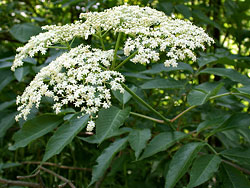Back to: Health Information : Health Topics A–Z
European Elder
Keywords: black elder, elder, elderberry, elder flower, sambucus

© Karen Bergeron
On this page
- Introduction
- What It Is Used For
- How It Is Used
- What the Science Says
- Side Effects and Cautions
- Sources
- For More Information
Introduction
This fact sheet provides basic information about European elder—common names, uses, potential side effects, and resources for more information. European elder is a tree native to Europe and parts of Asia and Africa, and it also grows in the United States. There are several different types of elder, such as American elder, but European elder is the type most often used as a supplement.
Common Names—European elder, black elder, elder, elderberry, elder flower, sambucus
Latin Names—Sambucus nigra
What It Is Used For
- Parts of the elder tree—such as the berries and flowers—have long been used for pain, swelling, infections, coughs, and skin conditions.
- Today, elderberry and elder flower are used for flu, colds, fevers, constipation, and sinus infections.
How It Is Used
The dried flowers (elder flower) and the cooked blue/black berries (elderberry) of the European elder tree are used in teas, liquid extracts, and capsules.
What the Science Says
- Although some small studies show that elderberry may relieve flu symptoms, the evidence is not strong enough to support this use of the berry.
- A few studies have suggested that a product containing elder flower and other herbs can help treat sinus infections when used with antibiotics, but further research is needed to confirm any benefit.
- No reliable information is available on the effectiveness of elderberry and elder flower for other uses.
Side Effects and Cautions
- Uncooked or unripe elderberries are toxic and can cause nausea, vomiting, or severe diarrhea. Only the blue/black berries of elder are edible.
- Because of elder flower's possible diuretic effects, use caution if taking it with drugs that increase urination.
- Tell your health care providers about any complementary and alternative practices you use. Give them a full picture of what you do to manage your health. This helps to ensure coordinated and safe care.
Sources
- Elderberry. Natural Medicines Comprehensive Database Web site. Accessed on May 15, 2007.
- Elderflower. Natural Medicines Comprehensive Database Web site. Accessed on May 15, 2007.
- Elder (Sambucus nigra L.) Natural Standard Database Web site. Accessed on May 16, 2007.
- Elder flower. In: Blumenthal M, Goldberg A, Brinckman J, eds. Herbal Medicine: Expanded Commission E Monographs. Newton, MA: Lippincott Williams & Wilkins; 2000:103–105.
For More Information
- What's in the Bottle? An Introduction to Dietary Supplements
- Herbal Supplements: Consider Safety, Too
NCCAM Clearinghouse
The NCCAM Clearinghouse provides information on CAM and NCCAM, including publications and searches of Federal databases of scientific and medical literature. The Clearinghouse does not provide medical advice, treatment recommendations, or referrals to practitioners.
Toll-free in the U.S.: 1-888-644-6226
TTY (for deaf and hard-of-hearing callers): 1-866-464-3615
Web site: nccam.nih.gov
E-mail:
CAM on PubMed
Web site: nccam.nih.gov/camonpubmed/
NIH Office of Dietary Supplements
Web site: ods.od.nih.gov
NIH National Library of Medicine's MedlinePlus
European Elder Listing: www.nlm.nih.gov/medlineplus/druginfo/natural/patient-elder.html
This publication is not copyrighted and is in the public domain. Duplication is encouraged.
NCCAM has provided this material for your information. It is not intended to substitute for the medical expertise and advice of your primary health care provider. We encourage you to discuss any decisions about treatment or care with your health care provider. The mention of any product, service, or therapy is not an endorsement by NCCAM. |
NCCAM Publication No. D391
Created August 2007
Updated April 2008
Note: The PDF file requires a viewer such as Adobe Reader, which you can download free of charge from the Adobe Web site.
